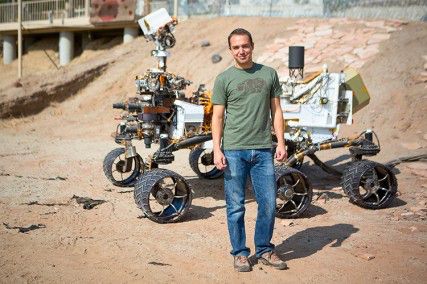After obtaining a master’s degree in mechanical engineering from Boston University in 2005, Matthew Heverly found himself working on NASA’s Mars Exploration Rovers teams.

Working as the lead planner and driver of the Mars Exploration Rovers, Heverly spent several years testing the robot in the MarsYard, or testing area, to make sure it could withstand the conditions of space and of the Martian environment.
There was a tremendous amount of pressure on making sure the rover worked, he said.
“Literally, the entire world is watching us do this,” he said. “It’s a $2.5 billion mission that’s a national asset, and we have the world watching us making sure we have to get it right.”
After a number of experiments, Heverly and the team completed the rover, weighing in at approximately 2,000 pounds —the size of a compact SUV with a seven-foot-long arm that can analyze and take photographs of rocks and other discoveries on the surface of Mars.
But few moments were as intense as when Curiosity entered the Martian atmosphere. Heverly was scheduled to work his first shift as the Curiosity driver, but he could not help wondering if the rover would make it.
“When we were watching this thing happen, I didn’t know if I would have a job to go to the next day,” he said. “If the rover didn’t land safely, all of our work would be for nothing.”
Water on the Red Planet
Eight years later, Heverly witnessed the rover discover water in the soil of Earth’s neighbor. The rover was instrumental in collecting the data that led to the discovery of water, and will hopefully start to fill in the unknown facts about the history of the red planet, especially the answer to the question everyone wants to know: Was Mars able to sustain life?
“It opened up the possibility of what could have existed in Mars, a past environment that was much more inhabitable,” he said.
Curiosity, which landed on Mars in August 2012, recently discovered water molecules in the surface level of soil, according to NASA. The journal, Science, published five studies from NASA detailing the rover’s discoveries, revealing that the red planet’s soil contains about two to 10 percent water by weight.
NASA’s team identified two types of soil that the rover has come across: a finely grained dust-like type called mafic and a course-grained component known as felsic. The water was found in the mafic soil, though its molecules were bound to other minerals in the soil.
All in a day’s work
Today, Heverly, now 37-years-old, continues to work on the Mars Exploration Rovers at the NASA’s Jet Propulsion Laboratory run by the California Institute of Technology, but he is now the mobility systems engineer. He drives the Curiosity rover, oversees the robot’s mobility, and processes its findings on the surface of the red planet. He is also a lecturer who teaches mechanical engineering and civil engineering at Caltech.
Heverly tracks the Curiosity rover’s progress on Mars, which is no simple task. The robot wakes up at 10 a.m., Mars time, to spend its day traveling the red planet’s surface and picking up soil samples. With 17 cameras and a microscope at the end of its arm, Curiosity takes numerous photographs through the day. At 5 p.m., the rover sends its daily report to the driver at JPL and turns in for a restful night.
That, more or less, is when Heverly’s workday begins.
Heverly and his team spends their 12-hour shifts reviewing Curiosity’s report and plans what the rover will do the next day, preparing a series of commands for it to complete.
“We hope we’re going to find a dinosaur bone every day, but you never really know what you’re going to find because you’re truly exploring,” he said. “We were thrilled to find that Mars had a habitable environment at the time, but we weren’t expecting it.”
In order to follow Curiosity’s progress, Heverly had to surrender eight-hour workdays and adjust his schedule to that of Mars. The solar day on Mars lasts about 40 minutes longer than one day on Earth.
When his team began the mission, Heverly worked many more consecutive shifts starting at 5 p.m. Mars time. Each day, he would have to get up 40 minutes later, sometimes starting his shift as late as 3 a.m
“Mars time was this amazing experience where the adrenaline of this amazing thing we were doing — that we’ve worked so hard for so many years to make happen — is actually happening,” he said. “Your body has to be able to adapt to this weird thing that it’s never done before, and at the same time, you’re trying to have a family life and pick up your kids from school.”
A father of two, Heverly sometimes had to take his children to school and go back home to nap until 5 p.m. Mars time.
Heverly’s work is more than just a job to him, and has also become a huge part of his family’s life. Since the day of the rover launch in Cape Canaveral, Fla., wich Heverly brought his family to witness, Heverly’s family has been interested in his work. His family has kept up with the rover’s journey, from the 354-million mile trip to Mars to its daily treks since it landed in August 2012.
Heverly’s older son, Paxton, who is four years old, has grown up following Curiosity’s mission, occasionally going into the laboratory with his father or looking at the photos the rover takes of Mars.
“It’s really interesting to see him have this unique relationship with this robot,” he said.
When I grow up…
Most people join NASA because they love space. Heverly, however, was more interested in the robots.
“It’s such a fun environment to be able to advance robots to do the things that we’re doing,” he said.
Heverly took his first robotics class during his undergraduate studies at the California Polytechnic Institute, San Luis Obispo and ended up getting a bachelor’s in mechanical engineering in 1999. He pursued robotics more as time went on, interning at JPL.
Heverly said he always found himself asking why something worked and wanted to answer those questions for himself.
Heverly joined the aerospace company Alliance Space Systems Inc., in Pasadena, Calif. The company was founded by a group of engineers who had worked at JPL, he said. He worked on several projects, including one that built an arm for Mars Exploration Rovers Spirit and Opportunity.
Heverly decided he wanted to pursue robotics projects related to space, so he went on to get his master’s degree in mechanical engineering from BU. He worked at the Boston Children’s Hospital, building robotic applications that assisted in pre-natal heart surgery.
That was the best part, he said — taking what he learned in school and applying it to real-world situations where he could help people.
“You weren’t just sitting in a classroom, reading the textbook,” he said. “At BU, we were able to just do it.”

























































































































